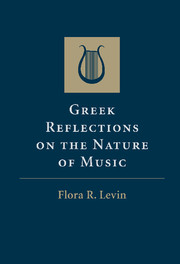Book contents
- Frontmatter
- Contents
- Figures
- Preface
- Introduction
- Abbreviations
- Texts
- 1 All Deep Things Are Song
- 2 We Are All Aristoxenians
- 3 The Discrete and the Continuous
- 4 Magnitudes and Multitudes
- 5 The Topology of Melody
- 6 Aristoxenus of Tarentum and Ptolemaïs of Cyrene
- 7 Aisthēsis and Logos: A Single Continent
- 8 The Infinite and the Infinitesimal
- ΣΦPAΓIΣ
- Bibliography
- Index
3 - The Discrete and the Continuous
Published online by Cambridge University Press: 21 October 2009
- Frontmatter
- Contents
- Figures
- Preface
- Introduction
- Abbreviations
- Texts
- 1 All Deep Things Are Song
- 2 We Are All Aristoxenians
- 3 The Discrete and the Continuous
- 4 Magnitudes and Multitudes
- 5 The Topology of Melody
- 6 Aristoxenus of Tarentum and Ptolemaïs of Cyrene
- 7 Aisthēsis and Logos: A Single Continent
- 8 The Infinite and the Infinitesimal
- ΣΦPAΓIΣ
- Bibliography
- Index
Summary
At the recurring end
of the unending
T. S.Eliot, Little Giddingone of the most perplexing musical questions familiar to everyone was raised early on by Aristoxenus in his Harmonic Elements: What is it that makes one melody musical and another unmusical? The full implications of his answer to this central question should become clear by considering the way in which he dealt with more specific problems, in particular, with the more controversial ones. Of these problems, one of the most important concerns the proper analysis of the concept of the continuum – the topology, as it were, of melody, and the notion closely allied to it – that of infinity. The problems connected with the continuum and with that of infinity arise in an early stage in Aristoxenus' reflections on two issues that pertain to melody: the apparently unlimited possibilities available to the human voice of placing notes in continuing sequences on the line of pitch; the apparently limitless possibilities granted to the human voice of subdividing the distance between any two of these sequential pitches. These problems reemerge at later and more subtle stages in Aristoxenus' analysis about discrete and continuous quantities and their relation to the continuum of melody.
In the earliest stages of his education, Aristoxenus would have probably concerned himself with infinity, not on its own account, but as it related to Pythagorean mathematical theory – a relation that, especially in Pythagorean harmonics, was very close.
- Type
- Chapter
- Information
- Greek Reflections on the Nature of Music , pp. 88 - 120Publisher: Cambridge University PressPrint publication year: 2009

